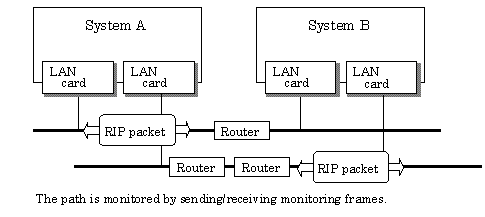

| PRIMECLUSTER Global Link Services Configuration and Administration Guide: Redundant Line Control Function 4.1 (for Solaris(TM) Operating System) |
Contents
Index
 
|
| Chapter 2 Feature description | > 2.1 Overview of Functions | > 2.1.2 RIP mode |
The shortest path to the remote system is selected based on the RIP packet received from the neighboring router and the selected path is used for communication. Then, monitoring is carried out to check whether any RIP packet is received from the router. If a RIP packet is normally received, the transmission line is considered to be normal. If no RIP packet is received within a specified period of time, the transmission line is considered to be faulty and the line to be used for communication is switched in accordance with the routing information received from another router. Monitoring is carried out for each router connected to NIC. Routing control via RIP is performed by the Solaris system.

If a failure occurs in a line, up to five minutes are required to switch the network paths via RIP.
The following failures can be detected:

Because the failures in (1) to (4) appear to be the same failure, it is not possible to determine under which of the four failure types these failures should be classified. Each device has to be checked to make this determination.
Monitoring is started automatically when the virtual interface is activated. Monitoring is automatically stopped when the virtual interface is inactivated. In cluster operation, monitoring is started or stopped along with the start or stop of a RMS.
Contents
Index
 
|